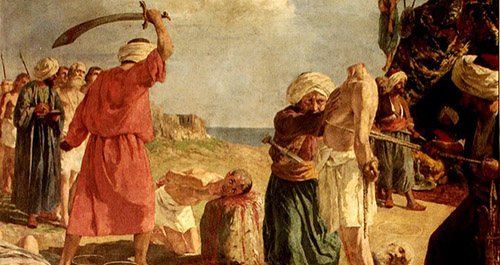
The martyrs of Otranto
Monday, October 2, 2017
*Rogelio Zelada
In the calm summer of 1480, a dark cloud of boats threatens the horizon of Otranto, the easternmost city of the Italian peninsula. Terror, desolation and anguish are permeating the defenseless city as the half crescent is seen waving on the masts of the approaching fleet.
Ninety galleys and galliots with a crew of 150 men and 18,000 experienced soldiers are seeking revenge for the frustration of not being able to take the fortress of the island of Rhodes. Despite his fearsome army, Gedik Ahmed Pasha could not defeat the courage of the Christian knights. He is now looking for a port to enter the Italian peninsula and has specific orders from Sultan Muhammad al-Fatih, who sent him to conquer the Kingdom of Naples and reach the See of Peter itself, where he dreams of turning the Apostolic Palace into a large barn. From Rhodes, the Ottoman sent his ships to the port of Brindisi, but the winds have diverted him farther south, leading him closer to Otranto, a quiet, isolated village, an easy prey for his soldiers.

Detail of the painting in the Naples cathedral depicting the beheadings of Christians in Otranto in 1480, perpetrated by Ottoman invaders. The artist depicts Antonio Primaldo as standing even after his beheading, a symbol of his firmness of faith.
The defense of the city has fallen to a people untrained for war, simple neighbors, anglers, artisans, shepherds and farmers. The rich, nobles and soldiers lowered themselves with ropes from the walls of the castle, and fled in terror in the darkness of the night.
From July 28 to August 11, without weapons and with few means at their disposal, the people of Otranto resisted the fierce siege but the Turkish bombs demolished the city’s walls, houses and roofs little by little. With wild fury, the shrapnel hits mercilessly on the civilian population that has taken refuge within the castle and its cathedral. The concentrated cannon fire manages to take down the weakest part of the wall, and like a killer sea, the soldiers burst through the gap, scimitar in hand, slaughtering anyone who gets in their way.
They go to the cathedral, the last refuge of the population, knock down the door and occupy all the exits. Stefano Pendinelli, the old archbishop, who was distributing the Eucharist and comforting the faithful, was ordered to renounce Christ and embrace Islam. They gave him a choice: Mohammed or the sword. The archbishop, clad in pontifical vestments with cross in hand, responds to the assailant by inviting him to convert to Christ, the only Savior. As the prelate encouraged the refugees to put their lives in the hands of God, he was torn to pieces by the edge of the scimitars and his head placed on a stake at the entrance of the city.
Gedik Ahmed Pasha ordered that women and men younger than 15 be set apart to be sold as slaves. The rest, 813 men, were ordered to convert to Islam or be killed. An old and respected tailor, Antonio Pezulla, called the Primaldo, responded on behalf of all: “We believe that Jesus Christ is the only begotten Son of God, and we prefer to die a thousand times before renouncing him and becoming Muslims.”
Primaldo turned towards the Christians and said, with deep faith and full confidence in the Lord: “My brothers, until today we have fought and defended our country for the glory of our leaders. Now the time has come to fight to save our souls for the Lord who died for us on the cross; therefore, it is expedient for us to die for him. May we remain secure and constant in faith, because with this earthly death we will gain eternal life and the glory of martyrdom.”
Everyone shouted that they preferred to die rather than to deny Christ Jesus.
At dawn, all were taken to the Hill of Minerva in groups of 50, half-naked and with ropes tied around their necks. There, they professed their faith before their beheading. Primaldo, who fervently encouraged the rest, was the first to have his head cut off; 813 people were beheaded in front of their families, forced to witness the massacre. The bodies remained unburied and uncorrupted on the hard rock for more than a year, until September 8, 1841, when Otranto was liberated and the relics of the martyrs were transferred to the cathedral.
We do not know the names of each of these martyrs. We only learned about Antonio Primaldo, whose name heads the cause of canonization. Pope Clement XIV recognized the historicity of the martyrdom in 1771 and approved the devotion. Benedict XVI approved the martyrs’ canonization in 2013, but the ceremony was presided over by Pope Francis in St. Peter's Square on May 12 of that year. It was the greatest number of saints canonized on a single day in the history of the Church.
Today, the witness of these martyrs remains very much in force. We live in times when the terrible fundamentalist hatred that killed more than 12,000 people in Otranto and violently enslaved more than 5,000 women and children just for remaining faithful to the faith of Jesus Christ seems to repeat.
On his visit to Otranto, St. John Paul II asked people not to forget “the martyrs of our time” and not to behave “as if they did not exist.”
“They have left us two essential gifts: love for one’s earthly homeland and the authenticity of the Christian faith. The Christian loves his earthly homeland. Love of country is a Christian virtue.”
Pope Benedict recalled that the martyrs of Otranto made clear “the need to preserve the inner authenticity, so heavily committed by the trust in Him.” … “To have martyrdom before our eyes means for the Church today to assume the proper attitude towards the world” which is precisely the attitude “of the martyrs of all times, who knew how to find in the promise sufficient light to walk to the encounter with the Lord who comes, enduring tribulation, never quenching hope.”
The Hill of Minerva is now called the “Hill of the Martyrs,” and their feast is celebrated August 14.

